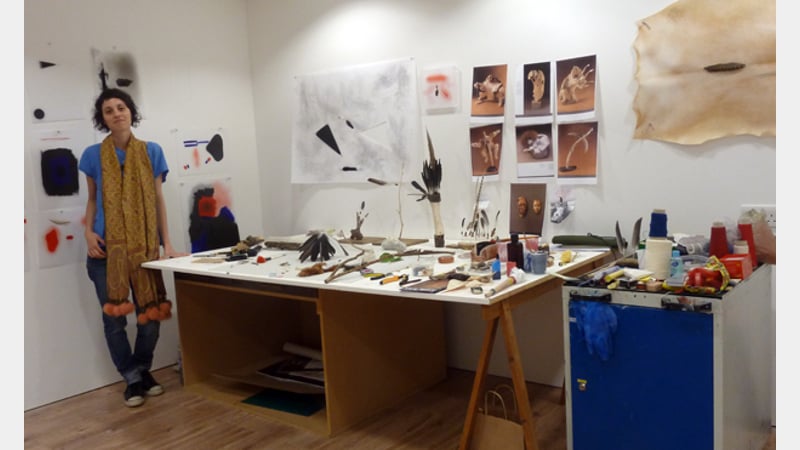As part of her three-week residency at West Dean College, Brazilian artist Daniela Antonelli gave an evening presentation about her work to an audience of MA students and Summer School attendees. Following a discussion about the development of her practice, how it related to the current experiments taking place during the residency, as well as a short film about John Baldessari, Daniela showed the audience around her work space in the adjacent studio.
Having initially trained as a designer, Daniela explained that she had made a decision to address any perceived lack of formal training by going about the task of self-education as an artist through a methodical, systematic process of setting and testing limits. This process has continued to feed the work she makes and the ideas she explores. Such methods echoed the type of constraints used by artists and writers throughout the modern period - for example, members of Oulipo [Ouvroir de littérature potentielle or 'workshop for potential literature'] - using a set of limitations that allow the practitioner to discover specific formal possibilities or, through their exhaustion, seeing where imposed rules break down and the unanticipated breaks through.Daniela stressed her fundamental interest in drawing and indicated that this was a core part of her approach in finding, as she put it, 'what is essential'. The use of systems aided her in breaking things down into component parts, as well as identifying a 'tool box' of material with which to work. The seemingly endless possibilities of limiting one's palette, as it were, led Daniela to set out a series of principles upon which to expand her own language of making: diagrams and plans, using ink on paper, crucially not moving into three dimensions; basic compositional elements such as dot, line and plane (echoing Kandinksy and Klee); the use of primary colours only, as well as white and black; the selective use of visual 'tools' such as the grid, etc. These key areas combined and re-emerged throughout her practice in a number of ways.
As the presentation continued, it became clearer that the emphasis on drawing in Daniela's practice is inherently linked with a concern for the more or less deliberate marking of surfaces and/or objects in a way that then associates them with what might be described as the appearance of the cultural - what she described as 'traces of civilisation' - whereby ostensibly natural objects are transformed, by the trace of a human hand, into worked artefacts of some kind or other (something that is then able to 'tell' of its role and place within human relations), however mediated it might be. This interest led Daniela to explore the aesthetic of ritualised objects and the specific markings on various sacred artefacts, amulets, icons and so on. How processes of arrangement and manipulation transform natural materials into meaningful compositions of signification and juxtaposition runs through Daniela's practice.As well as a two-dimensional pieces emerging from this study, Daniela had also developed sculptural works, often in interactive and wearable forms. By incorporating found objects, combining them with an overwriting activity or placing them in relation to other items, the work begins to establish a complex grammar of placement, setting up constructed assemblages that speak of traditions and associations within material objects that are always just out of reach. The assemblages have a conscious investment in questioning balance, both of the collated objects and the potential significance they speak to, and it was particularly interesting here to consider Daniela's use of the term 'micro-climates' when discussing the construction of specific contexts in which these pieces could exist - for example, isolating them in vitrines, employing museum standard plinths and supports, etc.Before taking the audience over to her working area, Daniela touched on the current preoccupation with images of continuum, self-renewal and annihilation (ourobouros), relating it back to a previous project in which an enormous scroll drawing unfolded according to an intuitive narrative structure that seemed to self-generate and repeat. As with many of her other works, the piece involved a huge investment of time and labour, and served to encourage the viewer to linger for a long time, encouraging them to look again and go back to the beginning.
During my three-week residency at West Dean College I created a body of work totally influenced by the atmosphere that surrounded me. My work is deeply connected to this practice and it first emerged from abstract drawings before moving towards object-making using found materials. My proposition was to continue developing this research using raw material collected around the College grounds. West Dean is a wonderful place to gather different kinds of natural elements such as feathers, small pieces of discarded wood, and so on. Bringing these items back to the studio I was able to find the peace and structure necessary to dive in the work.As the weeks progressed I became more and more involved in the process of making and collecting, finding inspiration in the landscape and within. West Dean is a place that provides external silence and internal quietness. The exchanges with some of the MA students and academic staff made it possible to establish a dialogue and have a more intense exchange. Also, due to the possibility of using the different workshops I was able to explore a wider range of technical possibilities.The experience at this residency was an opportunity of a lifetime. I was able to really concentrate on my practice, count on the support of a skilled team of professionals, converse with artists from different fields and, most importantly, look at the work from a different perspective. No pressure, no rush. Just thinking, conceiving and making.Daniela Antonelli





